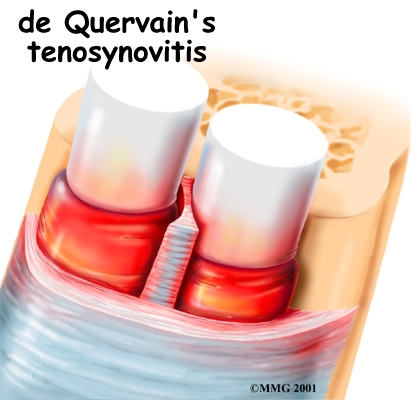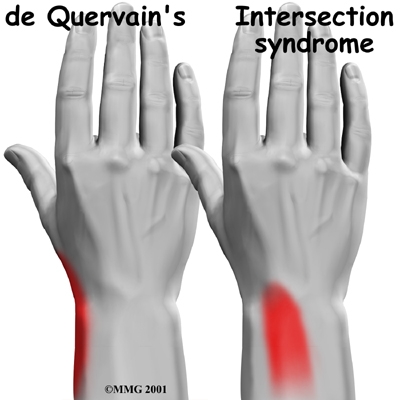A Patient's Guide to de Quervain's Tenosynovitis

Introduction
de Quervain's tenosynovitis is a condition that causes pain on the inside of the wrist and forearm just above the thumb. It is a common problem affecting the wrist and is usually easy to diagnose.
This guide will help you understand
- how this condition starts
- how to recognize the symptoms
- what can be done to stop the pain
Chiropractic Treatment
If at all possible, you must change or stop all activities that cause your symptoms. Chiropractic care focuses on not just relieving the symptoms, but correcting the underlying problem. Chiropractic manipulation can help restore the normal alignment and motion of the thumb and carpal bones in the wrist joint. This is sometimes called closed reduction manipulation. Take frequent breaks when doing repeated hand and thumb actions. Avoid repetitive hand motions, such as heavy grasping, wringing, or turning and twisting movements of the wrist. Keep the wrist in a neutral alignment. In other words, keep it in a straight line with your arm, without bending it forward or backward.
We may recommend a special forearm and thumb splint called a thumb-spica splint. This splint keeps the wrist and lower joints of the thumb from moving. The splint allows the APL and EPB tendons to rest, giving them a chance to begin to heal.
Your chiropractor may check your workstation and the way you do your work tasks. Suggestions may be given about the use of healthy body alignment and wrist positions, helpful exercises, and tips on how to prevent future problems.
Anatomy
What part of my thumb and wrist is causing problems?
de Quervain's tenosynovitis affects two thumb tendons. These tendons are called the abductor pollicis longus (APL) and the extensor pollicis brevis (EPB).
Tendons connect muscle to bone. Muscles pull on tendons for movement. The muscles connected to the APL and EPB tendons are on the back of the forearm. The muscles angle toward the thumb.
On their way to the thumb, the APL and EPB tendons travel side by side along the inside edge of the wrist. They pass through a tunnel near the end of the radiusbone of the forearm. The tunnel helps hold the tendons in place, like the guide on a fishing pole.
This tunnel is lined with a slippery coating called tenosynovium. The tenosynovium is a slippery covering that allows the two tendons to glide easily back and forth as they move the thumb. Inflammation of the tenosynovium and tendon is called tenosynovitis. In de Quervain's tenosynovitis, the inflammation constricts the movement of the tendons within the tunnel.
Causes
How did this condition develop?
Repeatedly performing hand and thumb motions such as grasping, pinching, squeezing, or wringing may lead to the inflammation of tenosynovitis. This inflammation can lead to swelling, which hampers the smooth gliding action of the tendons within the tunnel. Arthritic diseases that affect the whole body, such as rheumatoid arthritis, can also cause tenosynovitis in the thumb. In other cases, scar tissue from an injury can make it difficult for the tendons to slide easily through the tunnel.
Symptoms
What problems does this condition cause?
At first, the only sign of trouble may be soreness on the thumb side of the forearm, near the wrist. If the problem isn't treated, pain may spread up the forearm or further down into the wrist and thumb.
As the friction increases, the two tendons may actually begin to squeak as they move through the constricted tunnel. This noise is called crepitus. If the condition is especially bad, there may be swelling along the tunnel near the edge of the wrist. Grasping objects with the thumb and hand may become increasingly painful.
Diagnosis
What tests will my doctor want to do?
Doctors usually diagnose de Quervain's tenosynovitis easily through a physical examination. Most of the time no fancy tests are required. The major problem can be distinguishing de Quervain's tenosynovitis from intersection syndrome, which is a very similar condition.
Careful attention must be paid to where the pain is located--over de Quervain's tunnel near the end of the radius bone, or over the intersection point on the wrist. The intersection point is about three inches up the forearm.

The Finklestein test is one of the best ways to make the diagnosis. You can do this test yourself. Bend your thumb into the palm and grasp the thumb with your fingers making a fist with the thumb inside. Now bend your wrist away from your thumb. If you feel pain over the tendons to the thumb, your problem may be de Quervain's tenosynovitis.
All content provided by eORTHOPOD® is a registered trademark of Medical Multimedia Group, L.L.C.. Content is the sole property of Medical Multimedia Group, L.L.C.. and used herein by permission.
All materials from eORTHOPOD® are the sole property of Medical Multimedia Group, L.L.C.. and are used herein by permission. eORTHOPOD® is a registered trademark of Medical Multimedia Group, L.L.C..
|